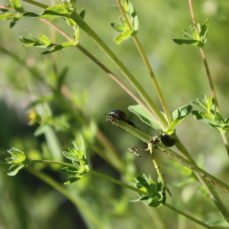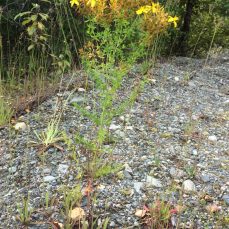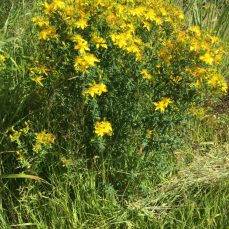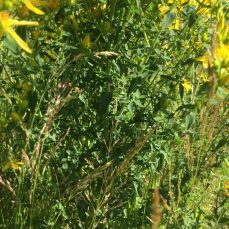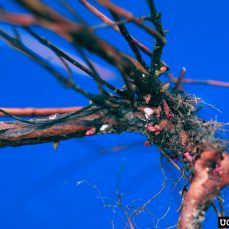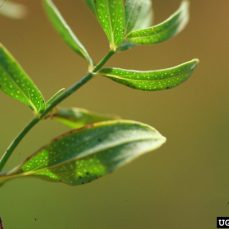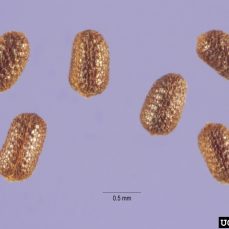
Management Category
Squamish
Whistler
Pemberton
Vectors of Spread
Synonyms
Common St. John’s wort is also known as:
- Common goatweed
- Klamath weed
- Tipton weed
ID Characteristics
Flowers: The bright yellow flowers have five petals that are 8 – 10 mm long. They grow in clusters of 25 – 100 flowers.
Stems: The stems are erect, smooth, and grow up to 1 m tall. Each plant can produce multiple stems which turn rusty red at maturity. The stems are woody at the base, but they branch out and grow leaves in the upper half.
Leaves: The leaves are thin and elliptical with a rounded base. They have distinctive transparent dots that are visible when held up to the light.
Seeds: Seeds grow in small, sticky membranous capsules. The seeds are very small (about 1 mm long), densely pitted and shiny dark brown.
Roots: Common St. John’s wort has a rhizome root system that develops just below the soil surface and extends 45 cm.
Similar Species
Invasive
Common tansy (Tanacetum vulgare): The button-like flowers lack petals.

Tansy ragwort (Senecio jacobaea): The daisy-like flower heads have 10-15 petals.

Habitat and Origin
Native to Europe, western Asia, and northern Africa. It was likely introduced to North America as an ornamental and medicinal herb.
Common St. John’s wort prefers dry, sandy soil in full sun and can be found in low- to mid-elevation areas on the coast, in grasslands, and forested areas in BC. It can also be seen along roadsides, rail lines, grazing areas, and disturbed sites.
How It Spreads
Common St. John’s wort reproduces both vegetatively (via its root system) and by seed. On average, one plant produces 15,000 to 34,000 seeds each year. As a result, a seed bank quickly accumulates in the soil, since the seeds are viable for up to 10 years and they have a gelatinous coating that helps them survive in harsh conditions. Common St. John’s wort can also reproduce through its root system, as the lateral roots can form new buds that are separate from the parent plant.
Common St. John’s wort spreads aggressively by vegetative reproduction through its root system. Long-distance dispersal occurs through the transport of seeds. The seeds can spread by water, wind, animals, and human activity.
Impacts
Ecological:
- Reduces biodiversity by displacing native species.
- Dense stands reduce food sources for wildlife.
Economic:
- Toxic to livestock.
- Reduces crop quality and quantity.
Health:
- Contact with sap causes skin to be sensitive to light, which can lead to irritation in the sun.
Stop the Spread
Common St. John’s wort is found in the Sea to Sky region and its distribution is beyond landscape-level control. When Common St. John’s wort is present at high-priority locations and negatively impacting them, their control is considered a high priority.
Otherwise, the goal is to prevent it from spreading to new (uninfested) areas, and to control it where possible to limit its impact on biodiversity.
Learn to identify Common St. John’s wort: use the images presented in this profile page to learn how to identify Common St. John’s wort.
What to do if you spot it: You can report any Common St. John’s wort sighting by clicking here.
DO:
- Regularly monitor properties for weed infestations.
- Minimize soil disturbances and promptly revegetate disturbed areas to prevent the growth of Common St. John’s wort.
- Check wildflower mixes to ensure that they do not contain Common St. John’s wort.
- Ensure all flowering heads or buds are bagged or covered to prevent spread during transport to designated disposal sites.
DO NOT:
- Do not unload, park or store equipment or vehicles in infested areas; remove plant material from any equipment, vehicles or clothing used in such areas and wash equipment and vehicles at designated cleaning sites before leaving infested areas.
- Do not plant Common St. John’s wort in a garden, no matter how well-contained its enclosure may seem.
- Do not move soil, gravel, or fill that has been contaminated with Common St. John’s wort.
- Do not compost any flowering heads or buds. Instead, dispose of Common St. John’s wort in the general/household waste stream at the landfill as the seeds will be able to persist the composting process.
Control
Mechanical control
- Tillage followed by the sowing of perennial grasses and legumes can be effective.
- Hand pulling/digging is not effective because it cannot effectively remove the extensive root system and cause roots to re-sprout.
- The removal of the stems (through grazing, fire, defoliation etc…) also stimulates re-sprouting.
Chemical control
- Several herbicides have been effective against Common St. John’s wort. Herbicide treatments of 2,4-D, aminopyralid, glyphosate, metsulfuron and picloram are the most effective post emergence and before bloom.
- However, picloram is not suitable for wet, coastal soils.
We recommend that any herbicide application is carried out by a person holding a valid BC Pesticide Applicator Certificate. Before selecting and applying herbicides, you must review and follow herbicide labels and application rates; municipal, regional, provincial and federal laws and regulations; species-specific treatment recommendations, and site-specific goals and objectives.
Biological control
- There are numerous biocontrol agents available for Common St. John’s wort.
- However, plants may continue to spread when treated with biological control agents.
- The most effective are the foliar feeding beetle Chrysolina hyperici, the foliar feeding beetle Chrysolina quadrigemina, and the root feeding beetle Agrilus hyperici.
Sea to Sky Distribution
Common St. John’s Wort Factsheet
References
- Alberta Invasive Species Council, St John’s-wort
- Coastal Invasive Species Committee, St. John’s Wort
- Invasive Plant Atlas of the US, common St. Johnswort
- Invasive Species Council of BC, St John’s Wort
- Invasive Species Council of Manitoba, St. John’s Wort
- University of California, Weed Control in Natural Areas in the Western United States
- US Department of Agriculture, St. Johnswort
- Washington State Noxious Weed Control Board, Common St. Johnswort







